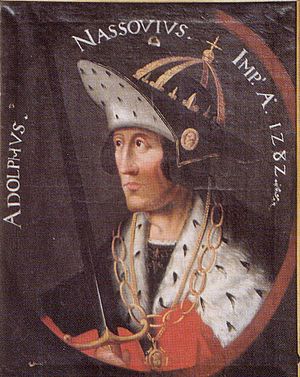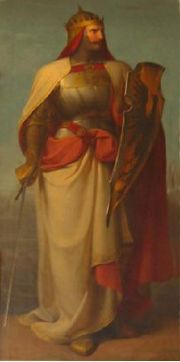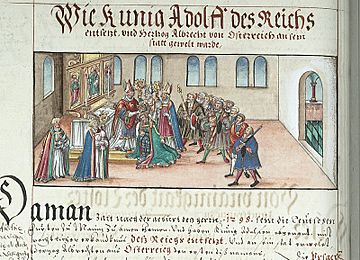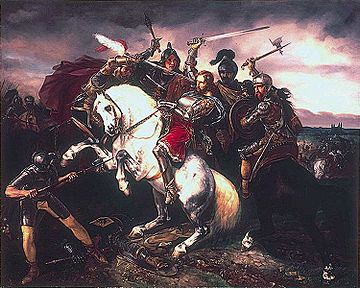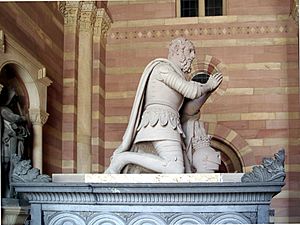Adolf, King of the Romans facts for kids
Quick facts for kids Adolf of Nassau |
|
|---|---|
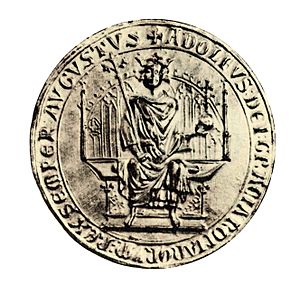
Small throne seal of Adolf of Nassau (1298)
|
|
| King of Germany | |
| Reign | 5 May 1292 – 23 June 1298 |
| Coronation | 24 June 1292 Aachen Cathedral |
| Predecessor | Rudolf I |
| Successor | Albert I |
| Count of Nassau | |
| Reign | ca. 1276 – 2 July 1298 |
| Predecessor | Walram II |
| Successors | Robert VI |
| Born | 1255 |
| Died | 2 July 1298 (aged 43) Göllheim |
| Burial | 29 August 1309 Speyer Cathedral |
| Queen | Imagina of Isenburg-Limburg |
| Royal House | House of Nassau |
| Father | Walram II, Count of Nassau |
| Mother | Adelheid of Katzenelnbogen |
| Religion | Roman Catholic |
| Signature | |
Adolf (born around 1255 – died 2 July 1298) was a powerful count. He became the elected King of Germany in 1292. He ruled until 1298 when other powerful princes removed him from power. Adolf was never crowned by the Pope. This meant he didn't get the full title of Holy Roman Emperor. He was the first healthy ruler of the Holy Roman Empire to be removed without the Pope's approval. Adolf died soon after, fighting against Albert of Habsburg, who became the next king.
Contents
Who Was Adolf of Nassau?
Adolf was born around 1255. His father was Walram II, Count of Nassau, and his mother was Adelheid of Katzenelnbogen. Adolf had a brother named Diether of Nassau. Diether later became the Archbishop of Trier in 1300.
In 1270, Adolf married Imagina of Isenburg-Limburg. They had eight children together.
Adolf's Early Life as a Count
Adolf became the Count of Nassau around 1276 or 1277. He inherited lands south of the Lahn River. These included places like Wiesbaden and Idstein. He also shared ownership of the family's original lands around Nassau and Laurenburg castles.
Around 1280, Adolf had a conflict with the Lords of Eppstein. During this time, Wiesbaden was damaged. Sonnenberg Castle was also destroyed. The conflict ended in 1283. After that, the city and castle were rebuilt. Sonnenberg and Idstein became Adolf's main homes. He gave Idstein special town rights in 1287. He also built its defenses.
Adolf became known at the court of King Rudolf I. King Rudolf gave him control of Kalsmunt Castle in Wetzlar. A year later, he also gained control of Gutenfels Castle near Kaub.
Before becoming king, Adolf was involved in politics in the Middle Rhine area. He was known for working with the Archbishops of Cologne and Mainz. Adolf was also quite educated for his time. He could speak German, French, and Latin.
After he became king, Adolf spent less time in his home county. He left the local government to his officials. In 1294, he bought Weilburg. He gave Weilburg town rights in 1295. He also founded a monastery for nuns near Wiesbaden in 1296.
Becoming King of the Romans
King Rudolf I of Habsburg died in 1291. He wanted his son, Albert, to be the next king. However, powerful princes, called prince-electors, disagreed. They wanted to choose a king freely. They didn't want the crown to be passed down like an inheritance.
The Archbishop of Cologne, Siegfried II, suggested Adolf of Nassau. The electors agreed to choose Adolf. But they made him promise many things. Adolf had to give them land, castles, and money. He also promised to help them against their enemies.
On 27 April 1292, Adolf signed an agreement. He promised to give the Archbishop of Cologne many things. He also promised to give other electors similar benefits after he was chosen. For example, he promised King Wenceslaus II of Bohemia to take back lands from Albert of Habsburg. These lands had belonged to Wenceslaus's father.
On 5 May 1292, Adolf was elected King of the Germans in Frankfurt am Main. He was crowned in Aachen on 24 June by the Archbishop of Cologne.
Adolf's Time as King
When Adolf became king, he didn't have much power. He was chosen because the electors thought he would be a weak ruler. This meant they could control him. However, Adolf soon started to act more independently. He made agreements with people who were against the electors. For example, he supported the rights of the city of Cologne.
Adolf also broke his promises about the lands of Austria and Styria. He gave these lands back to Albert of Habsburg. This showed that Adolf was a clever diplomat. He also held many court meetings. He renewed a general peace agreement for ten more years.
Adolf used the feudal system to gain power. He asked spiritual princes for payments when they were given their lands. Many people at the time thought this was wrong. But today, some historians see it as a new way to get money for the government. He also worked to get back lands that once belonged to the empire.
Alliance with England
In 1294, Adolf made an alliance with King Edward I of England. This was against France. Adolf received a large sum of money from England. This money helped him recruit soldiers. He declared war on the French king. However, Pope Boniface VIII ordered peace. He threatened to remove Adolf from the church if the war started.
Policies in Thuringia
Adolf also got involved in a conflict in Thuringia. He bought the land from its ruler, Albert the Degenerate. He used the money he got from England for this. This move was legal. He also took control of another area, the Margraviate of Meissen.
This action affected the interests of four of the electors. The Archbishop of Mainz claimed some of the land was his. King Wenceslaus of Bohemia was worried about Adolf's growing power. All the electors had hoped to gain from the conflict in Thuringia themselves. Adolf fought two campaigns to secure these new lands. He proudly announced that he had increased the empire's possessions.
Adolf's Removal from Power
The electors likely didn't plan to remove Adolf at first. But his actions in Thuringia caused problems. In 1297, the electors of Brandenburg, Saxony, and Bohemia joined forces. The Archbishop of Mainz also joined them.
In 1298, King Wenceslaus II and Albert of Habsburg made a deal. They agreed that if Adolf was removed, Albert would become king. The Archbishop of Mainz tried to get Adolf and Albert to settle their differences. But they almost went to battle instead.
On 1 May 1298, the Archbishop of Mainz called Adolf to his court. He claimed he had the right to judge the king. Adolf saw this as a challenge. He refused to attend the meeting.
On 23 June 1298, the electors met. They accused Adolf of many crimes. These included breaking the peace in Thuringia. They also said he broke his promises to the Archbishop of Mainz. The electors decided that Adolf was not fit to be king. They said he had lost his royal title.
It's important to note that the Pope did not remove Adolf from the church. This was unusual. Usually, only the Pope could remove a king. The princes argued that since they elected Adolf, they also had the right to remove him.
Albert's Election and Adolf's Death
After Adolf was removed, Albert of Habsburg was elected as the new king. Adolf refused to accept this decision. The conflict between Adolf and the princes was decided on the battlefield.
On 2 July 1298, Adolf's army met Albert's army at the Battle of Göllheim. This small village is in modern-day Rhineland-Palatinate. Adolf was killed during the battle. His army then fled.
Albert did not allow Adolf's body to be buried in the Imperial Cathedral of Speyer. So, Adolf was first buried in a monastery. Later, his body was moved to Speyer Cathedral.
Adolf's Legacy
On 29 August 1309, Emperor Henry VII moved Adolf's remains to Speyer Cathedral. He was buried next to Albert, who had been killed in 1308. In 1824, Duke William of Nassau built a monument for Adolf in the cathedral. It shows King Adolf kneeling in prayer.
In 1841, Duke Adolf of Nassau ordered a portrait of King Adolf. This painting hangs in the Hall of Kings in Frankfurt. Since there are no real pictures of King Adolf from his time, this portrait is an artist's idea of him.
In 1858, Duke Adolf of Nassau created a special award. It was called the Military and Civil Order of Merit. It was named after King Adolf. This award is still respected today.
Adolf's Family
Adolf married Imagina of Isenburg-Limburg. Her parents were Gerlach IV of Isenburg-Limburg and Imagina of Blieskastel.
Their children were:
- Henry (died young)
- Robert (died 2 December 1304)
- Gerlach I, Count of Nassau-Wiesbaden
- Adolf (1292–1294)
- Walram III of Nassau-Wiesbaden
- Adelheid, who became the Abbess of Klarenthal Abbey (died 26 May 1338)
- Imagina (died young)
- Matilda (born before 1280 – died 19 June 1323). She married Rudolf I, Duke of Upper Bavaria.
See Also
 In Spanish: Adolfo de Nassau para niños
In Spanish: Adolfo de Nassau para niños
- German monarchs family tree
Images for kids


